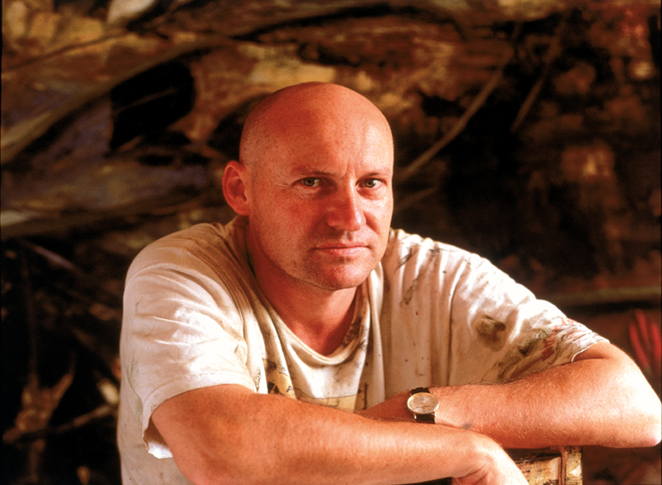
Richard Dunlop 2001 in front of ‘Still Life of How to Start a War’ (detail) 2001 oil on linen 152 x 304cm, Collection: Hugo Weaving
Painter of Cycles of Nature: Investigating Beauty and Tragedy
Lives and works in Deloraine (Co-Director, Deloraine Grainstore, 14 Parsonage Street, Deloraine, Tasmania, Australia 7304).
“I’m interested in transferring enduring images. I hope that as people leave a gallery and turn the corner, they see something freshly, visualise their own environment a little bit differently and see something I saw.”
Quote from an interview with Sue Smith, Manager of Curatorial Services, University of Central Queensland
“The meaning of my work will probably reside in the accumulation of images over time. I’m keen to make things that don’t exist and hope that they resonate with other souls. That’s it. Call it a serialised autobiographical narrative, a visual diary, a personal evolving garden, a small cathedral or whatever ancestors tried to create. I know that enough people will get it in time.”
Richard Dunlop 1992
“Richard Dunlop’s painting, Freshwater Eel (Colonial Style) is possibly the most accomplished painting in the show and was awarded the Painting Prize. It is a very refined piece of painting on a largish scale and commands a presence. The strangeness of the creature and the play with conventions of 19th century zoological illustration gives the work a slightly surreal feel.”
Professor Sasha Grishin, Australian National University, November 2012
“The subject of landscape is nature, and the most elusive thing about nature is that it is not reducible to any single quantifiable thing, such as trees or rocks or water or skies, even though the artist has to achieve mystery in the representation of all of these. The real subject of landscape is something ineffable: not its constituent elements but the whole that exists between them and can be communicated only by setting up a kind of electric interaction between them in the picture’s composition. The nearest sensible approximation to that ineffable whole is found in space and light, which is why they are so important to a landscape painter. Landscape is thus concerned with finding a way to make visible to the aesthetic imagination what can never be fully visible to the eye; it is ultimately a quest for the transcendence of the limits of the self, and so in a sense can be considered a spiritual pursuit.”
Christopher Allen, The Weekend Australian November 23-24, 2013

